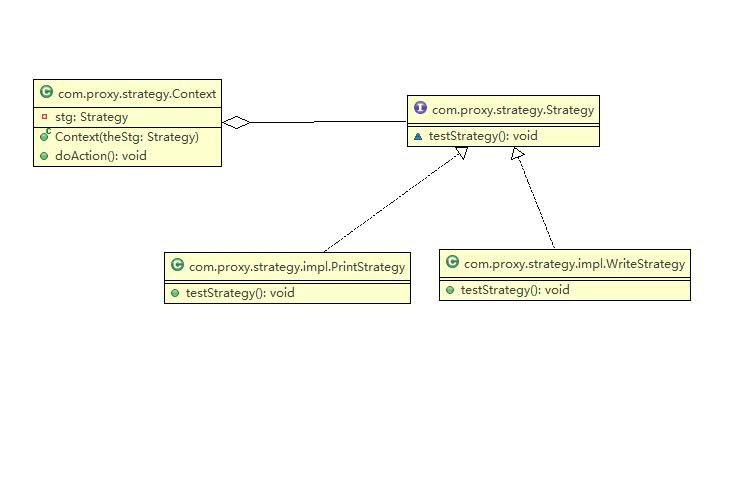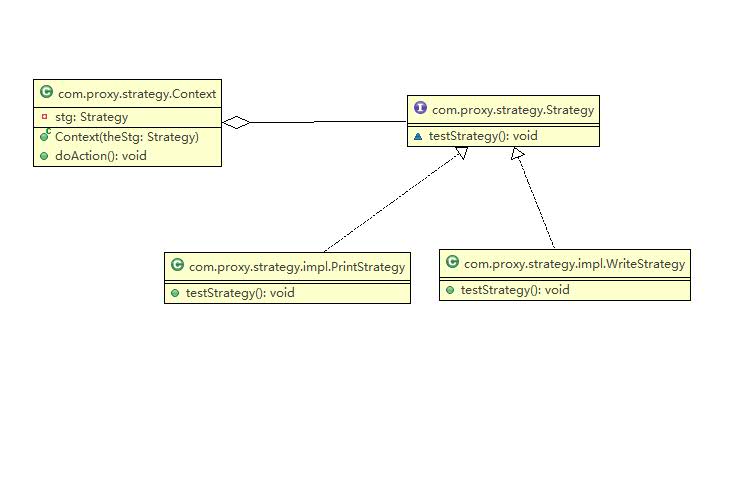Spring与策略模式
- 阿神asal
- 2016-11-07 17:45:482120semak imbas
一:策略模式的定义
策略模式是对算法的包装,把使用算法的责任和算法本身分隔开,委派给不同的对象管理。策略模式通常把一系列的算法包装到一系列的策略类里面,作为一个抽象策略类的子类。
其类图如下:

如果是要用JAVA类来实现的策略模式,其源代码如下:
Java代码
/**
*
* 策略执行
* @author weique.lqf
* @version $Id: Context.java, v 0.1 2014-2-9 下午2:32:56 weique.lqf Exp $
*/
public class Context {
private Strategy stg;
public Context(Strategy theStg) {
this.stg = theStg;
}
public void doAction() {
this.stg.testStrategy();
}
}策略接口:
Java代码
/**
*
*
* @author weique.lqf
* @version $Id: Strategy.java, v 0.1 2014-2-9 下午2:32:17 weique.lqf Exp $
*/
public interface Strategy {
void testStrategy();
}实现类一:
Java代码
package com.proxy.strategy.impl;
import com.proxy.strategy.Strategy;
public class PrintStrategy implements Strategy {
public void testStrategy() {
System.out.print("我要打印!!");
}
}实现类二:
Java代码
package com.proxy.strategy.impl;
import com.proxy.strategy.Strategy;
public class WriteStrategy implements Strategy {
public void testStrategy() {
System.out.println("我要写字!!!");
}
}执行代码:
Java代码
package com.proxy.strategy;
import com.proxy.strategy.impl.PrintStrategy;
public class StrategyClient {
public static void main(String[] args) {
Strategy stgA = new PrintStrategy();
Context ct = new Context(stgA);
ct.doAction();
}
}二:spring实现策略模式
现在使用spring的系统可以说是多如牛毛,那么如何在spring模式下实现策略呢?
其实只需要稍微改造下就可以了,因为spring的核心之一就是IOC。
首先修改Contex类:
Java代码
package com.proxy.strategy;
public class ContextSpring {
private Strategy stg;
/**
* Setter method for property <tt>stg</tt>.
*
* @param stg value to be assigned to property stg
*/
public void setStg(Strategy stg) {
this.stg = stg;
}
public void doAction() {
this.stg.testStrategy();
}
}然后在spring配置文件里面配置,
Xml代码
<bean id="ct" class = "com.proxy.strategy.ContextSpring">
<property name="stg" ref="writeStg"/>
</bean>
<bean id="writeStg" class = "com.proxy.strategy.impl.WriteStrategy"/>
<bean id="printStg" class = "com.proxy.strategy.impl.PrintStrategy"/>里面选择你将要注入的实现类,然后在执行的代码里面写这样:
Java代码
package com.proxy.strategy;
import org.springframework.context.ApplicationContext;
import org.springframework.context.support.ClassPathXmlApplicationContext;
public class StrategySpringClient {
public static void main(String[] args) {
ApplicationContext context = new ClassPathXmlApplicationContext("Beans.xml");
ContextSpring ct = (ContextSpring) context.getBean("ct");
ct.doAction();
}
}看,这样就将spring引入了。
但是这样有好处也有坏处,如果我要根据不同的类型,比如说:合同是需要打印的,而情书是需要手写的。假设合同为类型2,情书为类型1,那我们怎么来自动适配?
三:高级版的spring策略模式
首先要修改Context类:
Java代码
package com.proxy.strategy;
import java.util.HashMap;
import java.util.Map;
/**
*
*
* @author weique.lqf
* @version $Id: ContextSpringFactory.java, v 0.1 2014-2-9 下午3:46:09 weique.lqf Exp $
*/
public class ContextSpringFactory {
private Map<String, Strategy> stgMap = new HashMap<String, Strategy>();
/**
* Getter method for property <tt>stgMap</tt>.
*
* @return property value of stgMap
*/
public Map<String, Strategy> getStgMap() {
return stgMap;
}
/**
* Setter method for property <tt>stgMap</tt>.
*
* @param stgMap value to be assigned to property stgMap
*/
public void setStgMap(Map<String, Strategy> stgMap) {
this.stgMap = stgMap;
}
public void doAction(String strType) {
this.stgMap.get(strType).testStrategy();
}
}然后修改spring的配置文件:
Xml代码
<bean id="ctf" class = "com.proxy.strategy.ContextSpringFactory">
<property name="stgMap">
<map>
<entry key="1" value-ref="writeStg"/>
<entry key="2" value-ref="printStg"/>
</map>
</property>
</bean>执行的入口类修改为:
Java代码
package com.proxy.strategy;
import org.springframework.context.ApplicationContext;
import org.springframework.context.support.ClassPathXmlApplicationContext;
public class StrategySpringClientFactory {
public static void main(String[] args) {
//外部参数
String type = "1";
ApplicationContext context = new ClassPathXmlApplicationContext("Beans.xml");
ContextSpringFactory ctf = (ContextSpringFactory) context.getBean("ctf");
ctf.doAction(type);
//type 2
type = "2";
ctf.doAction(type);
}
}然后运行下,看看会有什么结果?

Kenyataan:
Kandungan artikel ini disumbangkan secara sukarela oleh netizen, dan hak cipta adalah milik pengarang asal. Laman web ini tidak memikul tanggungjawab undang-undang yang sepadan. Jika anda menemui sebarang kandungan yang disyaki plagiarisme atau pelanggaran, sila hubungi admin@php.cn
Artikel sebelumnya:Java.util包下BitSet的用法Artikel seterusnya:java各种排序算法及实现

